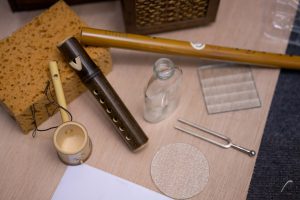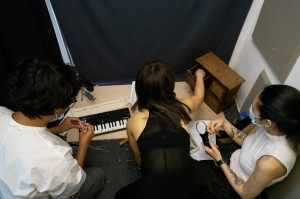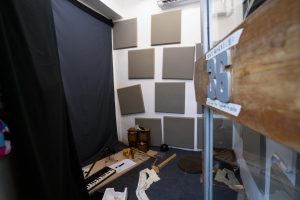artist support programme (ASP) alumni: Josephine CHAN Ching-man
「藝術家支援計劃」獲選藝術家:陳靖汶
閱讀完整訪談 (中文) >>>
–
Interview excerpt:
Josephine Chan Ching-man (b.1991) received her bachelor’s degree from the Department of Music, Kingston University (UK) in 2018, majoring in Composition. She has also begun working as a mounting and framing craftsman. Building on the past two-and-a-half years of her sound research, she now anchors her sonic focus on repetitive sounds – sounds from the home, from nature, and from her many handicraft activities. The series of works she is developing, included in ‘10 years of ASP’, have been created to work around the audience’s engagement with such experiences.
Josephine Chan Ching-man was supported by soundpocket’s Artist Support Programme 2019–20.
Personal website >>>
–
2.6.2021 (Wed)|6pm
Fu Lee Loy Shopping Centre, Hong Kong
◎ “Hop Hop Hum!” in ‘10 Years of ASP’
soundpocket: What is the installation you are working on for ‘10 Years of ASP’?
Josephine: Actually, I’ve always wanted to create something interactive in my work. I heavily lean on the gesture of touch when I am learning, so I hope my work contains elements that the audience can directly communicate with. I have been designing the prototype of “Hop Hop Hum!” since a few months ago, once I knew there would be a firm opportunity and space to exhibit it in Hong Kong. I have been considering how to fit it in with local elements. For the pre-recorded track, instead of using white noise recorded in the cityscape of Hong Kong, I decided to present an impression of Hong Kong – with mixed feelings of annoyance, humidity, and an overwhelming feeling. That’s the preliminary idea for the pre-recorded track. After that, I found several objects which are accessible at work or at home on a daily-basis, somethings that I’m fond of, and that also share a rich texture of sound. So, I toyed around with the objects, figuring out how to establish this seemingly surreal soundtrack. My experience gradually transformed into a work, an installation for the audience to experience through personal interaction.
soundpocket: Does this installation differ from your preliminary imagination of how to represent it?
Josephine: My intention for creating this artwork is to observe how the audience deals with sound. I thought the space would be a bit larger, and there would be many invisible and pure listening experiences, or even some calls and responses as in folk song singing – you couldn’t anticipate when the sound would be played, and I would create some delayed responses. However, as they are in the same space, the audience can try to play with the acoustic panels. I have also placed a microphone in the space in order to amplify the details of the sounds. In fact, this synchronicity also clarified what I wanted to achieve, it is about the co-existence of sound and noise, and I believe this space provides much more possibilities for the work.
Just now a member of the audience asked, ‘Did you come up with the work only after you had visited Fu Lee Loy Shopping Centre?’ I think I’d been very certain of the creative motifs I wanted to use, but it is only after being here that the work comes together in response to the surroundings. In fact, if this work is moved to another exhibition space, it will still carry the same motifs, but differ in terms of scale. Now though, I have created something interwoven with the shopping centre, so when the audience wander around the exhibition the shopping centre will not be separate from their experience.
soundpocket: During the exhibition opening, did you learn anything new from your interactions with the audience?
Josephine: At first, I assumed the audiences would be rather passive, that they would quietly listen to the pre-recorded tracks and wouldn’t touch anything. But everyone found the space very comfy: some thought the pre-recorded tracks were meaningless, and I told them to try every possible way to play around with the objects, or even to destroy the work. Initially, people just touch the prepared objects and giggle; but once they’ve found the sounds they like, they get immersed in experimentation. Actually, I recorded the audience’s reactions every session. I won’t use the recordings as a playback in the installation, but just to keep them as a record. When I listen to those recordings, I find them quite amusing as everyone was doing very different things – some of them even invented new methods or combinations that I would never have thought of. It turns out that the Hong Kong audience has been more willing to try interactive stuff than I had expected. I hope in the future I will create bolder sound installations, to deliver more possibilities for the audience to participate in the work.
◎ Interactive installation: A space for immersive listening
soundpocket: You mentioned “interactive” and “audience’s participation” a few times. What is the importance of the interaction and participation for you?
Josephine: We are often educated about art works such that we rarely imagine the possibilities in them. Let alone that artworks are mainly visual, and that when you enter the exhibition space, you see a lot of text that leads you to a certain context or mode of interpretation for the artworks you see. Actually this is not necessarily wrong, as for contemporary art appreciation, sometimes context is needed to make the artwork meaningful. However, I do hope that sound can bring out something more pure, something one can resonate with regardless of one’s background. In a raucous place like Hong Kong, it is hard enough to invite someone to sit down and listen. Lately when it comes to creating interactive installations, it has grown out of my motif of drawing people in to immerse themselves in listening, and I do hope others will listen to my artwork attentively, as a form of communication.



